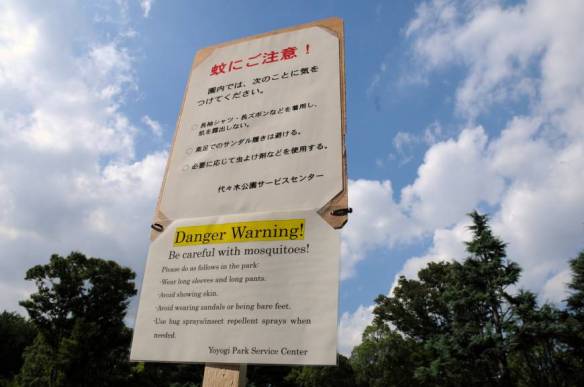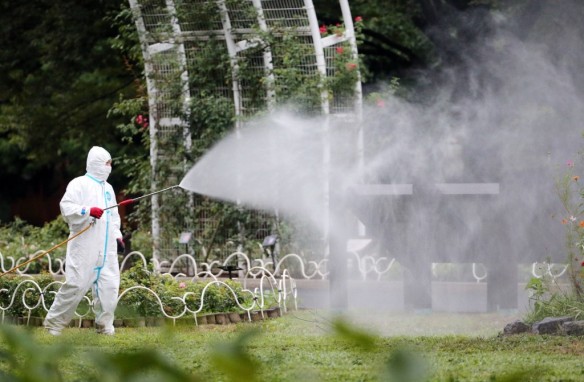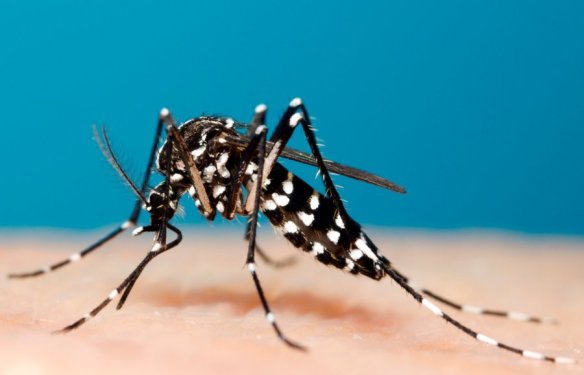 Considered free of dengue for around 70 years, Japan is now facing an outbreak of mosquito-borne dengue virus centered around a popular Tokyo city park. How could this happen?
Considered free of dengue for around 70 years, Japan is now facing an outbreak of mosquito-borne dengue virus centered around a popular Tokyo city park. How could this happen?
Dengue is typically associated with tropical regions. However, outbreaks of dengue have occurred in temperate regions historically. That includes major outbreaks in Japan. In fact, dengue has been a notifiable disease in Japan since 1999; regulated by the Infectious Disease Control Law.

Local authorities undertake spraying in Tokyo’s Yoyogi Park. (Photo Source: AFP via ABC News)
The first case of dengue in this current outbreak was reported at the end of August 2014 but in the space of a week or so, many more cases were identified. To date (9 October 2014) there has been a total of 151 confirmed locally acquired cases of dengue (this includes an Australian traveller). The majority to these cases have been centred around the popular Yoyogi Park in Tokyo.
[update 1 November 2014] Tokyo’s Yoyogi Park finally reopened after the outbreak was first detected but it was closed for 57 days. As well as a serious inconvenience to the people of Tokyo, there is little doubt this has had a substantial economic impact on the city. It would be fascinating to know if the outbreak impacted tourism.
[update 5 December 2014] A newly published paper reports on the molecular analysis of isolates of dengue virus from 19 confirmed cases of infection from Tokyo. The analysis showed that the outbreak was triggered by a single incursion of dengue virus type 1 (DENV-1) and that analysis of the envelope protein genome sequence from 3 patients revealed 100% identity with the strain from the first patient.
Some of the media coverage has focused in the role that climate change may have played on triggering this outbreak. However, the outbreak is not the result of a changing climate. International travel and a cool climate tolerant mosquito are to blame. Perhaps complacency regarding the risks associated with this mosquito predisposed the region to this outbreak too?

The Asian Tiger Mosquito, Aedes albopictus. (Source: Stephen Doggett, Pathology West – ICPMR Westmead)
The Asian Tiger Mosquito, Aedes albopictus, is a cool climate tolerant mosquito closely associated with water holding containers in urban environments. The mosquito is a severe nuisance-biting pest and second only to the Yellow Fever Mosquito (Aedes aegypti) in its importance in transmitting dengue virus. It is also very effective at transmitting chikungunya viruses. The expanding range of Aedes albopictus internationally is of critical importance to outbreaks of the disease. It is raising concerns regarding the transmission of chikungunya virus in North America this year.
Aedes albopictus provided the tinder that an infected traveller ignited to kick off this dengue outbreak.
There were warnings this was coming. Much of the media coverage has emphasised that this is the first local outbreak of dengue in 70 years. In fact, there was an intriguing case last year that should have put local authorities on notice.
In January 2014 there was news that a German tourist had contracted dengue. In Japan.
In a published case report, a woman sought treatment in a hospital in Berlin, Germany, in after returning from two weeks of travel in August-September 2013 to Honshu Island, Japan. Her travel route was via Frankfurt International Airport to Tokyo Narita International Airport and return. She did not visit any regions considered to have endemic dengue activity. The authors note that this case was “the first recognised case of locally acquired dengue (DENV) infection in Japan for more than 60 years”.
Following this reported case, authorities undertook surveys that revealed high population densities of Aedes albopictus within the urban areas of Japan. It is interesting to note that, despite using a surveillance method that is typically not effective at collecting Aedes albopictus (carbon dioxide baited light traps), some of the largest densities of mosquitoes were collected from Tokyo. Interestingly, a 2010 study into the blood feeding behaviour of Aedes albopictus in Japan showed that over 68% of mammalian blood meals identified were human and the authors concluded that the mosquito may play a role in outbreaks of dengue and chikungunya viruses.
I cannot find any reports of mosquito control, either source reduction or insecticide treatment, were undertaken in response to these findings.

Average number of Aedes albopictus collected using human bait collection and CDC miniature traps in urban areas of Japan in September 2013 (Source: International Journal of Infectious Diseases)
There are clearly some warnings that authorities, both in Japan and elsewhere, should take from this event. Most importantly, the presence of Aedes albopictus should not be underestimated in increasing the risk of local dengue outbreaks. While the published report of the dengue infection in the German tourist prompted debate (see here and here) about the future of local dengue outbreaks in Japan, it is clear now that where Aedes albopictus occurs, so does the risk of dengue. Control of this mosquito should be undertaken, not only to reduce the nuisance-biting impacts but to also reduce public health risk. Clearly, August and September seem to be a high risk period around Tokyo.
While locally acquired cases of dengue were unknown since the 1945, Japanese travellers were regularly returning home infected with the pathogens. A recent study of 540 Japanese travellers demonstrated that, not only was Indonesia and the Phillippines destinations of high risk, but that August and September were peak periods when infected travellers were returning home from these endemic regions. An eerie coincidence considering the cases in August/September in both 2013 and 2014. Where these traveller, not climate change, triggered outbreaks in Japan? (the debate about climate change driven dengue outbreaks in other regions of SE Asian could be left for another day)

Rate of reported dengue cases per 100 000 Japanese travellers by month and country visited, 2006–2010. It is interestign to note that only data for 2010 on travellers to Indonesia is reported. (Source: Western Pacific Surveillance Response Journal)
Australian authorities should take note of what has happened in Japan. While understanding the routes of entry of Aedes albopictus into new regions is critical, developing strategic surveillance and control responses to the introduction of the mosquito are of equal importance.
Since the discovery of Aedes albopictus in the Torres Strait in 2005, there has been much debate, together with data crunching and computer modelling, with regard to the possible spread of the mosquito across the mainland. There is evidence that the mosquito can survive at cooler climates in Australia and can spread some of our local pathogens. What will it mean for Australia to have a severe nuisance-biting pest and potential vector of dengue and chikungunya viruses inhabiting our major cities such as Brisbane, Sydney, Melbourne and Perth?
We should be mindful that this mosquito may not naturally spread south from the north, it may sneak in through the back door. It already has. The mosquito was discovered, and fortunately eradicated, from Melbourne in 2012. Exotic mosquitoes continue to be intercepted at our ports.
Perhaps we can’t stop Aedes albopictus reaching mainland Australia. Efforts continue to keep the mosquitoes at bay but, in reality, we may be overwhelmed. We cannot fill enough cracks to stop them slipping through.
What we need are strategic responses to the incursions of the mosquito. Authorities need to build capacity for quick response surveillance and control. Traps and insecticides are cheap, expertise on the ground by those responsible for catching and killing the mosquitoes is not. The traps and control measures currently used to control pest mosquitoes associated with wetlands will not be easily be transferable to the control of container-inhabiting mosquitoes. We need to review our approaches to mosquito control should Aedes albopictus be introduced. Time may be on our side for the moment but for how long? Will we one day see outbreaks of dengue in Sydney’s Centennial Park?
Why not join the conversation on Twitter?